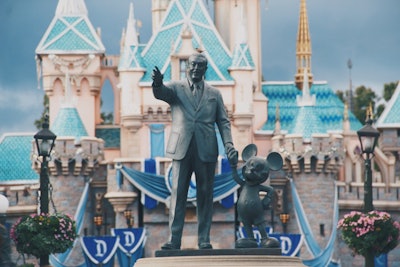
After being shuttered for more than a year due to COVID-19, Disneyland Resort swung open its gates to visitors once again on April 30. But the reopening is occurring in carefully orchestrated phases, and the Anaheim park and its operations look substantially different these days. Here’s what event professionals can learn from Disneyland’s intricately designed and precisely executed return to business as it emerges from crisis.
1. Address the elephant in the room—don’t ignore it.
As the pandemic recedes, Disneyland isn’t even trying to pretend it never existed—even for the happiest place on earth, that would be a bridge too far into the realm of fantasy. Instead, the facilities and its staff tackle the situation head-on in an on-brand and hospitable way. Sanitizer stations are abundant. Character meet-and-greets are modified with outdoor, socially distanced vignettes. Signage and staffers clearly communicate rules and expectations.  Prior to entering the park, guests are met with COVID-19-related signage, warning them of the risk as well as what health and safety protocols are to be followed before being allowed inside.Photo: Alesandra Dubin
Prior to entering the park, guests are met with COVID-19-related signage, warning them of the risk as well as what health and safety protocols are to be followed before being allowed inside.Photo: Alesandra Dubin
By readily acknowledging any salient real-world challenges that exist, event professionals can translate tough scenarios—whether related to public health, internal financials, a brand PR crisis or something else—into safe, digestible and on-brand environments that control their own messaging.
2. Don’t bite off more than you can chew.
With vaccines on the rise and caseloads on the decline, Disneyland saw its opening to resume face-to-face opportunities. But it’s taking a measured approach, opening in phases: The park is capping max daily capacity to a fraction of full capacity. It’s currently only open to California residents, and certain hotels, attractions and dining experiences are still modified or unavailable. This phased approach allows the organization to keep its emphasis on safety, staff training and the quality of the guest experience—and perfect the rollout before ramping up further.
3. Communicate abundantly and clearly.
With the landscape of COVID statistics and regulations changing swiftly, Disneyland prioritizes communication through every step of the attendee experience—from detailed online instructions connected to the online ticket purchase to signage beginning in the parking lot and repeated all throughout the park. Event professionals can’t change public health circumstances outside their control, but they can and must use all means within their control to communicate expectations and regulations to attendees and stakeholders through clear and continually updating messaging.
4. Enforce rules uniformly.
In an era when political viewpoints steer individual perceptions of facts, and when there is widespread confusion over rapidly shifting protocols, event professionals must determine the appropriate set of rules governing safety for their own events—and then adhere to them without equivocation. Guests must know what the expectations are and know that the rules will be enforced with clear consequences for violation (such as removal from the event). And they must know these rules will be enforced uniformly among the entire constituency, so there’s no room for individual exceptions that send a message of unfairness and stir conflict.
Despite shifting guidelines from the CDC, Disneyland maintains its mask policy and allows no exceptions. This creates a baseline that sets guests’ expectations of themselves, staffers and of each other.  Despite shifting guidelines from the CDC, Disneyland maintains its mask policy and allows no exceptions. Additionally, parkgoers are at risk of being removed from the property if they do not comply with the uniform rules and regulations.Photo: Alesandra Dubin
Despite shifting guidelines from the CDC, Disneyland maintains its mask policy and allows no exceptions. Additionally, parkgoers are at risk of being removed from the property if they do not comply with the uniform rules and regulations.Photo: Alesandra Dubin
5. Lean into technology.
Even as the event landscape shifted deftly to hybrid and digital formats during the pandemic, the crisis revealed plainly that there’s simply no substitute for face-to-face interaction, which provides not just unique business solutions but also fulfills a fundamental human need. Still, as live events and interactions return, event professionals can lean into the digital solutions necessitated by the pandemic to create a more streamlined, safer and richer guest experience.  Disneyland is encouraging guests to use their mobile platform for booking meals ahead of eatery arrival, completing cashless and contactless transactions, viewing and downloading photos, checking ride queue lengths in real time and more to help keep crowding in high-traffic areas to a minimum and reducing high-touch points.Photo: Alesandra Dubin
Disneyland is encouraging guests to use their mobile platform for booking meals ahead of eatery arrival, completing cashless and contactless transactions, viewing and downloading photos, checking ride queue lengths in real time and more to help keep crowding in high-traffic areas to a minimum and reducing high-touch points.Photo: Alesandra Dubin
Disneyland encourages guests to download its app, which, sure, serves the business’ bottom line with many opportunities to make in-app purchases and capture data. But it’s also a feature-rich mobile platform that authentically enhances the guest experience with options for booking meals ahead of eatery arrival, completing cashless and contactless transactions, viewing and downloading photos, checking ride queue lengths in real time and more.
6. Invest in staff training.
At Disneyland, you’d be hard-pressed to find a staffer—among thousands throughout the park—who can’t answer your question. Beyond just “where’s the bathroom,” all team members are well equipped to respond to nuanced questions with educated answers pertaining to directions, safety, protocols and more. The investment in staff training results in a safe, orderly environment that in turn earns attendees’ confidence.
And it’s that confidence—that a live event experience will be competently executed, safe and successful—that will facilitate conditions necessary for the industry to thrive again.



















